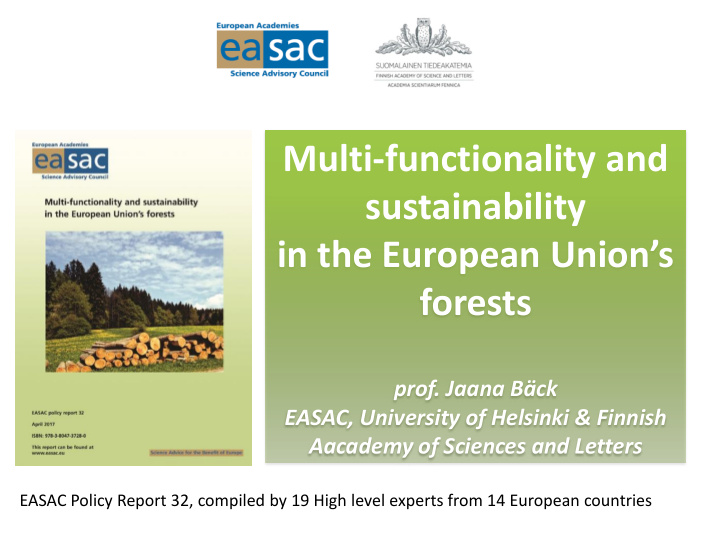



Multi-functionality and sustainability in the European Union’s forests prof. Jaana Bäck EASAC, University of Helsinki & Finnish Aacademy of Sciences and Letters EASAC Policy Report 32, compiled by 19 High level experts from 14 European countries
Main messages 1. Member states are not able to address the global challenges in biodiversity decline and climate change with national forest policies as efficiently as would be needed EU-level steering, transparent policies and incentives are needed 2. LULUCF should not allow transfer of emissions from other sectors (non-ETS) to forestry without any real decrease in net carbon emissions (bioenergy, reducing carbon sinks, imports) 3. The most efficient way to avoid risks, promote forest resilience and reach the Paris and biodiversity targets is to increase forest carbon stocks and promote heterogeneous mixed species forestry EP hearing, Dec 4 2017 2
Forests in EU • Diversity in history, ecological and climatic factors, stocks and growth, management, ownership • Forest growth has been increasing in last decades more than harvests • Forest biodiversity is under pressure in most MSs • Forestry is important branch in many economies Tree species map EU has only minor influence on the forest policy in Europe • EU has applied subsidiary principle and MS have more or less specified their forest policy according to national traditions and objectives • Biodiversity decline and climate change are problems that cannot be efficently managed without coordination among the MS EU should develop ways to account for the national differences but simultaneously set clear incentives for better and transparent policies following the international obligations, esp. Paris Agreement and Convention on Biological Diversity EP hearing, Dec 4 2017 3
Forests contribute to climate change • Climate benefits from forests: sequestering carbon, contributing to cloud formation, protecting from erosion, products for substituting FF and other C-intensive materials • Forest sink accounts for ca. 10% of EU fossil fuel emissions • Forest carbon sink and storage are dynamic and depend on forest management • Most of the carbon harvested will be back in atmosphere in a few (less than 10) years In future forest policies: The planned intensification of harvests for e.g. bioenergy will in short and medium term yield in loss of carbon sink and release of carbon from storage: no mitigation but possible acceleration of climate change Forests suffer from transboundary threats, e.g., climate change, alien species, deposition, fires, droughts, storms, pathogens: current management tools are not planned to increase forest resilience nor their climate impact EP hearing, Dec 4 2017 4
Biodiversity in forests is in decline • Forest structural elements, old growth forests, and forest continuity are crucial for biodiversity • Forest management is central in maintaining or loosing biodiversity values of production forests: genetic, species and habitat diversity • Good biodiversity implies often good productivity, resilience and climate benefits: – 10% decrease in tree species annual losses of 150- 420 billion € In future forest policies: Meeting biodiversity conservation targets is more important than ever, but compromised by intensification of use of wood Global and EU – level biodiversity conservation is hampered by exclusive Member State level land use planning Protecting the old-growth forests and maintaining deadwood in production forests are key tools for preserving biodiversity EP hearing, Dec 4 2017 5
Forests and climate change in EU -policy • EU bioeconomy policy: a strong boost to use forests in energy production No guarantee of any balance between using forest for energy production and increasing/maintaining the storage of carbon and forest multi- functionality • How are the country specific forest reference levels defined? if reference levels are loose with respect to BAU, countries have incentives to transfer emissions from other sectors (like non-ETS) to forestry without any real decrease in net carbon emissions countries should not benefit from high BAU carbon storage – only additionality matters What are the consequences if countries do not meet their forest reference levels? The worst case: countries use public subsidies for transferring emissions from non-ETS sector to LULUCF without any real decrease in net emissions EP hearing, Dec 4 2017 6
Socially optimal balance between carbon storage and wood utilization • Research clearly shows that including carbon storage always changes the socially optimal forest management (never “neutral”) • In production forests increasing carbon storage tends to increase rather than decrease long run timber supply, and also increase biodiversity values For e.g., Nordic countries, studies suggest that storing carbon into forests is among the cheapest methods to decrease net carbon emissions • Given carbon price of 10- 50 €/ tn, it would be optimal to store huge amounts of carbon in (at least) boreal forests (no analyses from other parts of EU exist) EP hearing, Dec 4 2017 7
How to create correct incentives? • In economical terms, carbon storage is a positive externality and carbon emissions from harvested wood are negative externalities • Externalities should be controlled via market interventions Subsidizing carbon storage and taxing (all) carbon emissions yields economically correct incentives, leading to “ Cleaner earns, polluter pays ” – principle • Subsidizing carbon storage is applied in New Zealand and Canada but EU lags behind EP hearing, Dec 4 2017 8
Economically sensible forest management and multi- functionality • Economically sensible wood production is not based on max m 3 • prices , costs, interest rates and forest owners’ objectives must be noticed • Economically sensible wood production should additionally be adapted to climate change risks and multi-functionality • Mixed species heterogeneous forest provide higher level of ecosystem services and multi-functionality To mitigate risks, they should be increased by forest management Single species, homogeneous forests Multiple species, heterogeneous forests 9 EP hearing, Dec 4 2017
Recommend
More recommend